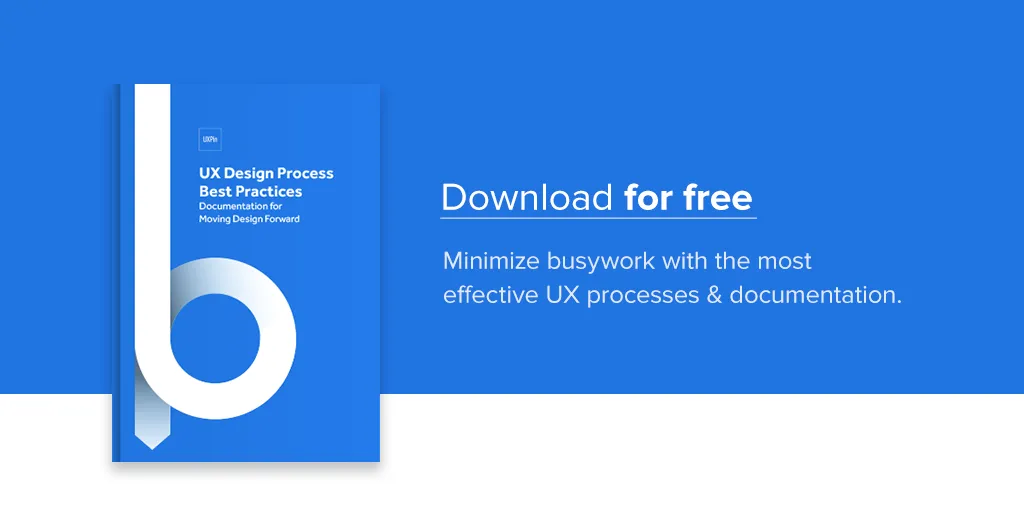The sales team might sell the job, but the design team sells the product.
While it’s frustrating to compromise on usability or experience because stakeholders request changes, it’s part of our job as designers to ensure that only happens when a positive outcome is in store.
When working together on a design project, nudge gently and respectfully to persuade clients, stakeholders, and/or coworkers to your line of thinking.
Here are a few tactics for gaining buy-in the next time you share a design with clients or team members. First, learn how to best present your work and the ideas behind it, and then learn to defend your decisions in a productive way.
Presenting Design
The first half of “getting to yes” with clients or stakeholders is presenting your work—and no one can sell design like a passionate designer. Here’s how to take advantage of that.
1. Present only one option—the right option
We learned this early at Brolik. It was commonplace at that time for advertising agencies to show multiple mockups to clients in a pitch.
We noticed that one mockup would always be a clear favorite internally, while the others just filled out the pitch. But clients seemed to never choose our favorite.
We challenged the status quo at the time and started showing a single, strong solution instead of multiple mockups. We explained why we only had one design and why we arrived where we did, and then we listened to feedback. The results were instantly better.
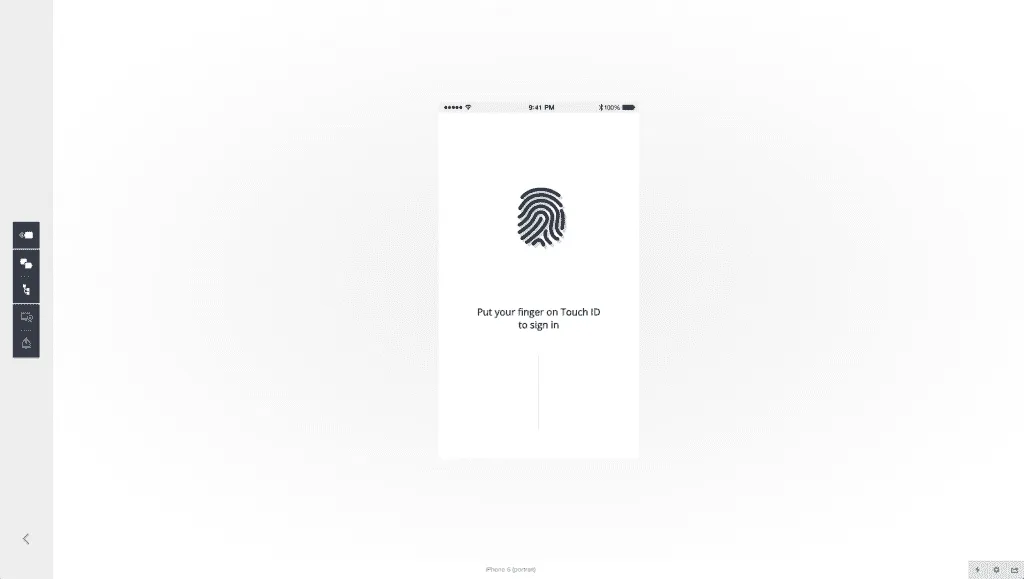
Due to the current Lean and Agile movement, multiple high-fidelity mockups are thankfully going away, but it’s worth noting a few things:
- Multiple choice means more second guessing. That’s bad.
- Spending time on a “second choice” design means time isn’t spent on the best option.
- Design is about problem solving, not opinion. There’s ultimately only one right answer.
Explain the why
In good design, there’s thought behind every decision, and sometimes clients just need to know that.
They might not know what goes into the design process, but if they feel like you’re glazing over the details, it can lead to distrust—and that’s an intangible expense you want to avoid. People also like to debate specific reasoning and design decisions, which is perfectly helpful and should be encouraged.
If they don’t agree, don’t fight it; just make sure you get your “why” on the table to frame the discussion. Be straightforward, relating all your points back to hard usability data and business goals.
In the below example from the UXPin team, notice how Marcin Treder opens up his first comment by immediately referencing user research. Since he’s already set the precedent for evidence-based design, he can cite that same research when responding to further comments down the chain.
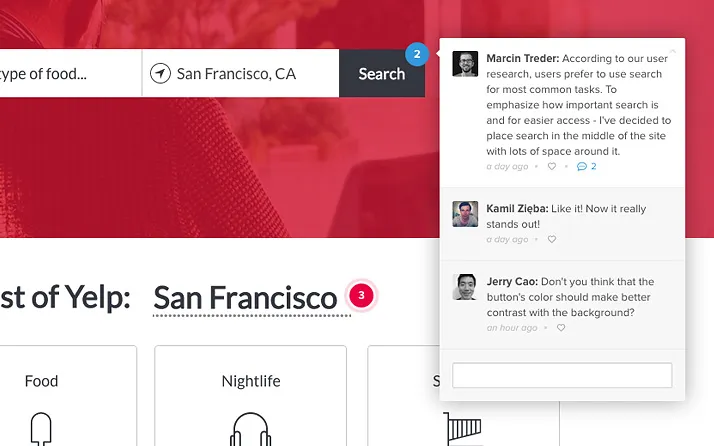
3. Be passionate but honest
At a client or stakeholder meeting, it might feel inappropriate to be honest about bumps in the process or to admit that your assumptions were wrong, but a little vulnerability goes a long way.
Talk openly about frustrations. You’ll usually get some laughs, and in the process, everyone in the room will be better aligned with your solution. Also talk about your favorite part(s) of a design, pointing out areas where you went the extra mile and feel proud of the results. If you show that you own the work, stakeholders will instinctively trust you more.
At Brolik, we act and speak passionately when we present our work, and it’s been a success with clients. For example, we might openly tell a client, “We’ve never done a site like this, but it’s the best website we’ve ever built” (if that’s the case). The honesty goes a long way to opening positive lines of communication.
Defending Design
The second half of getting to yes is defending your ideas after you’ve presented them.
It’s not always easy to graciously accept critique of your work, especially when it’s dismissive, but here’s how to do it in a productive way that ultimately helps achieve your goals as a designer.
1. Counter opinion-based comments with logic
Whenever a project stakeholder suggests a change, ask them why. Keep peeling back layers of “why” until you’ve gotten to the core of the client’s issue. Since it would be annoying to repeatedly ask “why” (like a three year old), we frame the question in useful and non-condescending ways.
One method is to ask for facts or statistics to back up someone’s opinion. As you can see in the comments in a recent project from the UXPin team below, the dialogue needs to be a helpful exercise, not a personal challenge.
It should be something like: “That’s an interesting perspective. Have you seen any data that brought you to that conclusion or is it more of a gut instinct?” When they say it’s a gut instinct, you can reframe their situation from a user’s perspective: “While that makes sense, as a user, if I were going to X, I’d most likely need Y and Z to happen first. I’ve seen case studies that back this thinking up, as well. I’m happy to send over those if you’d like.”
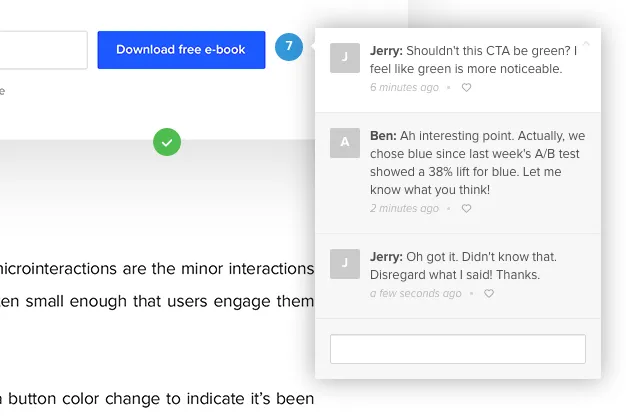
It’s harder to argue with logic. Some clients let their egos get the best of them in the moment, but I’ve found that good logic backed by user testing and user research will usually set in with time and eventually win out.
I’ve found the easiest way to present user data is to let the facts speak for themselves and empathize with clients or other team members whose assumptions were wrong. The second an “I told you so” attitude creeps in, everyone will shut down. Instead, I like to take the stance of “I’m just as surprised as you are. Data is a crazy thing. It’s a good thing we did this testing, though!”
2. Back up decisions with articles
Your clients are not usually up on the latest industry research and information. So share it with them!
Starting on the same page and aligning assumptions goes a long way toward reaching a happy conclusion. And industry knowledge is also useful for helping to back up your original decisions. Sometimes just showing that an article exists is enough to convince a client of your argument.
I think A List Apart is a great source for articles that demonstrate the level of thought that goes into design decisions, and usually in a way that doesn’t bore non-designers. Smashing Magazine is another great resource that gives credibility to the work we do.
I’m convinced that the actual content you share with clients is of less importance than the simple act of sharing. Sharing shows you’re passionate and thoughtful, and it also shows that our industry is nuanced, well-educated, and professional (as opposed to the classic “my nephew can do my website” view).
3. Filter comments for their true meaning
When someone else critiques your design, they’ll usually frame their critique in a solution. Your job is to find the core problem hiding in that feedback.
Identifying the root issue takes practice and skill, but the first step is to ask them why. Dustin Curtis’ 3 question rule is a great investigative tactic. In the below example, you can see how to apply this tactic to close out comments faster.
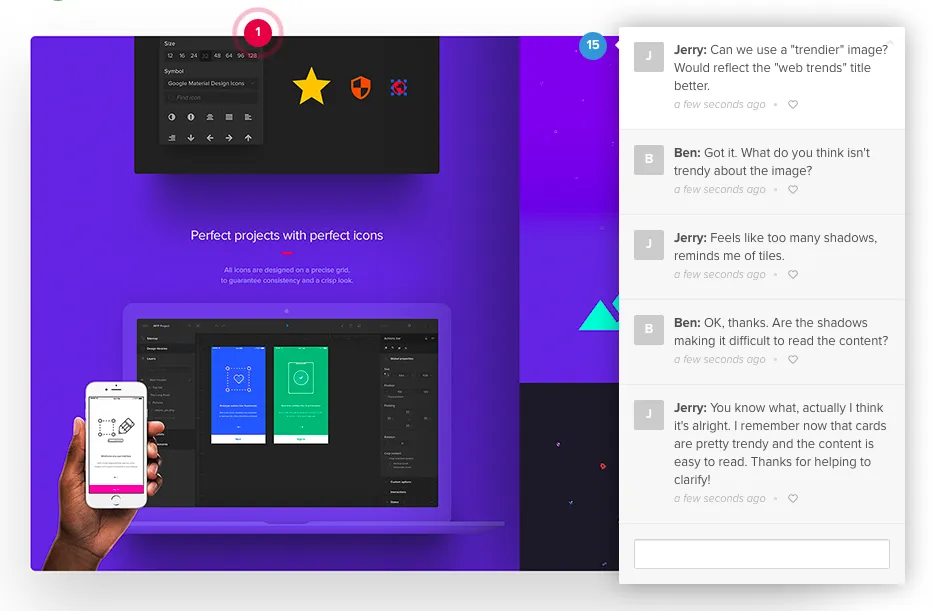
Photo credit: Recent project by UXPin product team
In the same way that presenting why is important, it’s equally important to require someone with an opinion to explain their own why. Asking that simple question is often enough for someone to really think about what they’re fighting for.
If they still push, the next step is to present alternatives in a non-threatening way. By that I mean, “I see where you’re coming from, but I’ve seen other sites do X, Y, and Z.” If you’re comfortable enough, follow with: “Will your idea be more effective than those solutions?”
We can’t always reach decisions this way, and at some point, it comes down to who’s paying the bills. That’s one reason I believe in the single decision maker philosophy. Every decision should always come down to one person. If we establish this ahead of time, we can avoid the dreaded pitfall of design by committee. The decision maker can take everyone’s opinions into consideration and make the final call, which is typically a productive compromise based on everyone’s feedback.
Ultimately, though, being open to compromise is half the battle. Designing for clients (or for your boss) isn’t a win or lose contest. There’s almost always a way to give someone what they need without completely catering to their wants. It may require creative thinking, but the result is a more informed final product.
Get comfortable with not always being right
Most importantly, realize you’re not always right. No two design or business problems are exactly the same. Clients know their business and audience, so they’re a valuable resource for solving their specific design challenges. Remember to listen to them.
Also remember that it’s not a “right or wrong” contest. It’s easy to let our egos make it into one, but in design, we’re all on the same team.
If you don’t own or run the business, remember that, too. You can only do so much. It’s a designer’s responsibility to do our best job and offer the best solution, even if that means fighting for it, at times.
At the end of the day, don’t kill yourself over the small battles; just remember that the more we pay attention to how we’re presenting and reacting to feedback, the easier it will be to get to yes for the decisions that matter.
If you found this article useful, check out the free 100+ page e-book UX Design Process Best Practices.
Feature photo credit: Nitesh Jain via Sumo Logic

